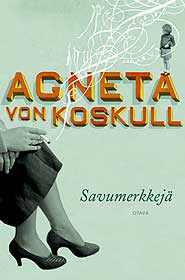Agneta von Koskull: Savumerkkejä (Från Twenty Gold till Kent)

From: Passed, with its sequel, onto me off a friend who’d read them and has a totally zen attitude to book ownership.
When: Probably two, maybe even three years ago.
Verdict: One of my favourite books of all time.
Fate: Immediately passed on to an aunt who might also love it.
This book is written in Swedish. I read it in Finnish.
First of all: if you know Finnish or Swedish, you MUST read this book. Especially if you happened to grow up in or love Helsinki. In fact, if you just happen to love Helsinki, or weird and wonderful stories of bourgeois Scandinavian families (ranging from Tove Jansson to Ibsen and Strindberg) you must call a publisher immediately and demand an English translation.
Agneta von Koskull is born into an upper-class family at the exact point in the late 1940s when class society in the traditional sense is starting to disappear in the Nordic social democracies. But regardless of having lost their aristocratic status to history and their money to bad investments, the von Koskulls still remain elite in the cultural sense. Agneta herself will grow up to be a painter (this novel was her belated writing debut) and family life is an utterly civilized affair.
That said, the fifties childhood of Agneta and her sister Renata is not without its complications. Their parents’ marriage is threatened by their mothers’ periodic drinking and the girls themselves are not growing up at the same pace – Renata’s friends, a particular nuisance, often preventing the younger girl from joining the most interesting games.
The whole novel is narrated, almost Portrait-of-the-Artist-style, in the utterly charming and plausible voice of a very young girl. Many of the laugh-out-loud funny bits, of which there seems to be one about every three pages, come from the deadpan way she observes phenomena of the grownup world. When the older girls take to spying on people in the Hesperia Park, for instance, their favourite catch is always a man lying on top of a woman, grunting. Agneta dislikes the sight of the grunting men, which makes the older girls snigger. The witnessing of sexual acts actually reoccurs at different points in the story, and von Koskull does an amazing job at reflecting the girl’s developing understanding of what is going on without ever resorting to moralism or underestimating her child narrator.
The von Koskulls live on Apollogatan in Helsinki’s Tölö, where I too grew up; I went to school across the street from the institution which young Agneta detests so that she will run off to Hamburg in time for the sequel. My recollections of the neighbourhood are, I realize, far more sentimental than hers. That von Koskull’s Tölö is magical is a result not at all of any real properties of central Helsinki but of the fact, which she makes me remember vividly, that growing up anywhere can be both difficult and magical, and befuddling, and exciting.